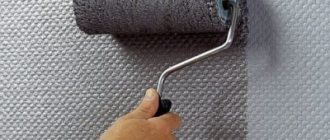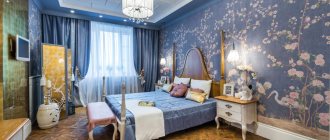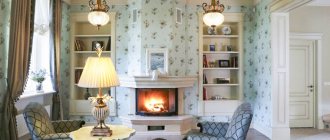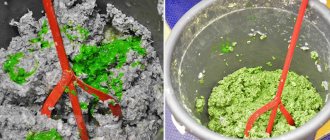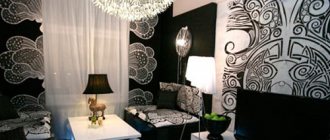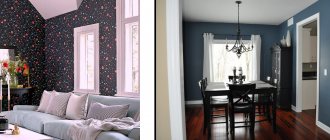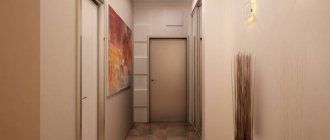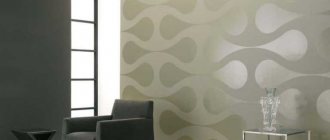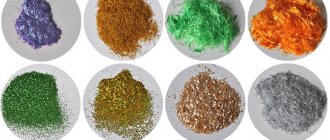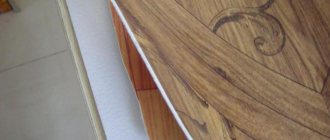Applying liquid wallpaper, taking into account all the features of the finishing material, is not a difficult process to master. The length of its service depends on the correct preparation of the wall, preparation of the mass and application of silk plaster. Surely each of us has performed unfamiliar work at least once in our lives. Only after completion do you understand that everything was much simpler - you just had to follow the technology and study the issue a little in advance. We tried to make our article just such a methodological guide.
What is liquid wallpaper?
A type of finishing material used to decorate walls and ceilings. The material, in essence, differs from conventional wallpaper coverings and is more related to decorative plaster. Liquid wallpaper is purchased in dry form and then diluted with water before use.
Are they harmful?
Liquid wallpaper is a safe and environmentally friendly product. They are suitable for decorating a children's room and other living spaces, as they contain natural ingredients. The coating does not emit harmful substances even when exposed to high temperatures.
Compound
As mentioned above, high-quality liquid wallpaper does not contain critical ingredients that can be harmful to health. An exception may be low-quality products from unscrupulous manufacturers.
- Liquid wallpaper is based on cellulose fiber or cotton, which is about 90 percent of the total composition. It is not uncommon to use waste paper, wood and textiles after recycling.
- Additives to improve technical characteristics. Antiseptics are added to increase resistance to the formation of mold, mildew and bacteria on the surface.
- Binding base. Bustilate, PVA, wallpaper glue, paste can be used as glue.
- Decorative additives of various kinds. Additives solely for aesthetic effect and adding texture: beads, glitter, silk fibers, dye, flock, velor.
Characteristics
Liquid wallpaper has a number of characteristics that may influence the decision to choose a finishing material.
| Quality | Index |
| Flammability | Resistant to fading |
| Life time | 6-8 years |
| Antistatic properties | Eat |
| Surface layer thickness | 1-2 mm |
Floor coverings
To imitate brick in floor coverings, a concrete mixture and a special stencil are used. A stencil imitating masonry is applied to freshly laid concrete and rolled with a special roller. The coloring compound is rubbed into the slightly hardened concrete.
To reliably reproduce brickwork on the floor, clinker floor tiles are used, which are particularly durable and abrasion-resistant.
The technology for laying clinker tiles on the floor is no different from laying tiles made from other materials.
Types of liquid wallpaper
Liquid wallpaper can be divided into two subgroups: according to the material from which they are composed, or according to the external effect.
By material
Cotton
They are almost 100 percent made of natural material and contain only a small part of additives in the form of glue, mica and decorative particles. The finished coating is warm and pleasant.
Pulp (paper)
The most budget-friendly type of liquid wallpaper, otherwise called paper. Made from wood processing product. The material is suitable for finishing cold rooms and premises, such as balconies.
Silk
They are the most durable type of liquid wallpaper. The coating mainly consists of silk fibers. The coating is “not afraid” of ultraviolet radiation, which means it will not fade or change color over time.
Silk-cellulose
The same applies to an inexpensive type of coating, not much different from paper. Silk threads are added to the composition for aesthetic reasons. Unlike silk material, they have a shorter service life.
By invoice
Smooth
Smooth liquid wallpaper will look like a smooth surface. They look more strict and correspond to modern design.
Embossed
They require more consumption during operation. Externally they look like soft canvas. They will look good in a classic room design.
Advantages and disadvantages
If we talk about the general impression, some people like liquid wallpaper, others don’t. But their properties are not bad. The advantages include the following qualities:
- Seamless surface. No joints like wallpaper. Smooth surface.
- If necessary, the imperfections of the walls are smoothed out, but this increases the consumption of the composition.
- The composition is vapor permeable, that is, it does not create problems for maintaining normal humidity in the room.
- Fits well on curved surfaces of any complexity.
- Easy restoration for any type of damage. There are two possibilities:
- in case of minor damage (scratches), simply wet it, wait a couple of minutes and smooth it with a spatula;
This defect is easy to fix
If there is a change in color or a significant defect, remove the old coating and apply a patch.
Not bad qualities. What is most impressive is the high maintainability. This is good if you have pets: scratches are simply rubbed out. If you also like the appearance of this coating, you should try it.
Liquid wallpaper also has disadvantages:
- They fade under the sun. In the southern room this must be kept in mind.
- Cleaning is dry only: you can collect dust using a vacuum cleaner and a soft brush.
- It is impossible to remove ingrained dirt and grease. Just remove the contaminated piece and apply a patch.
- Doesn't fit well on all surfaces. The easiest way to work is with rough ones, the worst thing is with absolutely smooth ones (the composition “drains”).
High maintainability - this is one of the best properties of wet wallpaper - For a good result, surface preparation is necessary - leveling significant unevenness, priming in several layers. If the surface has an uneven color, painting is also needed (usually white).
- Self-application requires a lot of time.
As you can see, there are some pretty serious drawbacks. The most unpleasant thing is the impossibility of wet cleaning. This is not always acceptable in the hallway or kitchen. This drawback can be mitigated by covering the wall with varnish. It can be washed, but cannot be restored. In addition, the varnished coating loses vapor permeability, but becomes water-repellent.
Advantages and disadvantages
When choosing a finishing material, you should consider all your needs. A detailed examination of the product allows you to make sure that you have made the right choice.
| Advantages | Flaws |
| Suitable for partial renovations | Takes a long time to dry after application |
| Seamless application | Not resistant to moisture |
| Do not deform over time | High price |
| Eco-friendly | |
| Improves sound insulation in the room | |
| Have thermal insulating properties | |
| Fireproof, suitable for application to the stove in the country |
Photo ideas in the interior of rooms
In the kitchen
In the kitchen, liquid wallpaper is suitable for decorating the dining area; for the cooking area it is better to choose a more moisture-resistant material, such as tiles or glass wallpaper. Thanks to the “breathable” surface, the possibility of the appearance of fungus and mold is minimized. Also, liquid wallpaper does not absorb odors, which is especially important in the kitchen.
In the hall
In the living room, you can use different methods of applying material, forming a pattern or unusual relief. The coating is perfect for creating an interior in different styles; it can imitate a concrete wall for a loft, have a smooth, even surface for high-tech or an unusual pattern for modern design.
On the loggia
Liquid wallpaper is suitable for finishing a closed balcony or loggia, as it does not tolerate contact with water, but there will be no problems with low temperatures or sunlight. A very practical way to decorate a space.
For the bathroom
When deciding to decorate your bathroom with liquid wallpaper, you need to remember about their inability to interact with water. Finishing should be done in places with the least possibility of contact with moisture.
In the hall
Liquid wallpaper is a simple and beautiful solution for decorating a corridor. For a small room, you should stick to a light color scheme. Floor-length mirrors and bright daylight will also help correct the situation. Liquid wallpaper is convenient for the hallway due to its ability to carry out fragmentary repairs.
In the children's room
The safety and environmental friendliness of the material plays a decisive role when decorating a children's room. Liquid wallpaper is just that. The soft and warm surface will decorate a child’s room, and the varied application method allows you to reproduce various patterns or three-dimensional pictures, such as flowers or butterflies for a girl’s room.
In the bedroom
The warm, breathable surface creates a cozy atmosphere and is perfect for decorating a bedroom. The composition of liquid wallpaper may include additional components for external decor, sparkles or glass beads. Liquid wallpaper can also be combined with other types of finishes, such as wallpaper or wood panels.
In the toilet
For a small toilet, liquid wallpaper is good because it can be applied without seams. Ordinary wallpaper cannot boast of such an ability and it is quite difficult to decorate a room with many corners with it. Considering the possible high humidity in the toilet, the surface should be varnished.
On the stairs
Liquid wallpaper on the stairs will look elegant and laconic, supporting the color scheme of the overall interior. In addition to a plain surface, the wall along the stairs can be decorated with various patterns or an unusual combination of two colors.
Bedroom
Once you stick liquid wallpaper in your bedroom, its design will change significantly. The bedroom is the best place to use them. It is this room that needs comfort and softness, where you really want to relax.
Example of use in the bedroom Source spp-group.ru
If you focus on one wall, then the one where the head of the bed is located is best.
To focus on individual zones, you can adhere to this rule, but it is not necessary Source mebel-go.ru
A bright bedroom is not the best choice for everyone. If both spouses insist on different colors, liquid wallpaper in the room can be combined.
Sometimes a bedroom in dark colors looks very atmospheric Source lumetri.ru
Dark tones and sparkles add unusualness and piquancy to the room Source free-lancers.net
Colors
White
White color looks quite strict; outwardly, liquid white wallpaper looks like plaster. Suitable for office decoration or modern home interior design.
Beige
A cream or beige shade will be a good solution for interior design in a classic style. The coating looks unobtrusive and tasteful; the shade goes well with many colors.
Yellow
Yellow color will add a pop of color to the interior of the room. A good solution for decorating the northern room of the house, yellow liquid wallpaper will compensate for the lack of sunlight.
Greens
Green color has a beneficial effect on a person, helps to relax and gives a positive attitude. A combination of different shades of green, such as olive and pistachio, will look interesting in the interior.
Gray
The gray color looks stylish and strict, visually similar to wet asphalt. Shades can be different and go well with white, beige and lilac tones. Gray color is suitable for decorating a hallway, hall, balcony or kitchen.
Black
Liquid wallpaper in black will look impressive as an element of decoration, and not as the main color. In black you can lay out an unusual pattern, decorate one of the walls or a fragment of a wall in the form of a geometric figure.
Brown
The brown tone creates a cozy, warm atmosphere. Coffee with milk is the most suitable tone for decorating a bedroom; the interior is calm and laconic.
Blue
Thanks to the structure of liquid wallpaper, the texture will look interesting against a blue background, forming irregularities similar to the surface of water. The color refreshes a sunny room well.
Lilac
Lavender and lilac shades look good in classic and Provence styles; shades can be delicate pale or rich and rich.
Purple
A darker shade of lilac. The color is beautiful, but its oversaturation in the interior can lead to depression. So it’s better to combine a purple tone with a lighter color scheme.
Blue
The smooth surface of the walls in a rich blue color will look impressive in a modern design and harmoniously decorate the classics. The finish can be combined with white, beige and chocolate tones.
Orange
A positive shade that is often chosen by creative people. Orange color improves mood, promotes communication and makes a room deprived of sunlight brighter.
Turquoise
A beautiful and exciting shade. The color of the sea wave is fascinating and is subconsciously associated with sea water. Looks especially good in a spacious, bright room.
Reds
By its nature, red is a rather aggressive and bold color. But its various shades can make the interior luxurious and harmonious. For example, a burgundy tone would look good in a classic living room.
Gold
For a spectacular appearance, glitter and sparkles are added to the liquid wallpaper, which give a golden shine in the light. Suitable for classic, Victorian or ethnic designs.
Peach
Delicate peach color can decorate any room. The tone is calm, unpretentious, but has its own charm and gives the interior a gentle and cozy atmosphere.
Pink
Pink color is combined with white, gray, blue and cream shades. You can combine different materials to create an interesting design, for example with photo wallpaper.
Combinations with other colors and surfaces
Different colors
The combination of two or more shades is a common practice in interior design. Different shades allow you to make it more complex and voluminous. Most often, two colors are used in decoration; there are a huge number of ways to combine them; liquid wallpaper can be laid out in the form of patterns, creating a single picture on the wall.
With other wallpapers
Liquid wallpaper is a rather “calm” material; wood, other types of wallpaper, and tiles will be successfully combined with it. One of the types of successful combination of materials can be called liquid and vinyl wallpaper, the latter are presented in a huge form, with different colors and types of production.
With decorative stone
A decorative stone, which can be of completely different textures, for example, imitating a brick or a rock fragment, is successfully applied to the flat surface of liquid wallpaper. The combination is practical for decorating a hallway, protecting corners from damage and abrasion.
Brick wall panels
It is not difficult to imitate a brick wall with your own hands using ready-made PVC panels. Different companies produce PVC panels of their own size, range of colors and textures. Brick wall panels are attached in different ways. The simplest option is gluing, however, some types of imitation panels require the creation of a sheathing made of wooden beams or a special metal profile. The last option is intended for finishing facades.
PVC tiles are wear-resistant, moisture-resistant and durable. Covering a partition with brick-like wall panels is a successful and economical replacement for tiling walls in sanitary rooms - bathroom, toilet, laundry room.
Wall finishing design options
Drawings and patterns
Using different shades on the surface of the walls or ceiling, you can lay out patterns or entire paintings. When finished, such work looks like a single drawing, without seams or extra lines. To decorate walls with liquid wallpaper with a pattern, it is better to resort to the help of craftsmen, since the work requires accuracy and skill.
With glitter
Decorative filler in the form of sparkles, bugles or glitter will add sparkle to the interior. Small inclusions shimmer beautifully in daylight and evening light.
Glowing
You can add luminescent decorative filler to liquid wallpaper; it is this that glows in the dark, creating a fabulous atmosphere. Glowing liquid wallpaper can be used to decorate children's rooms and bedrooms.
Marbled
Liquid wallpaper with quartz chips is visually similar to a marble surface. Also, the application technique can have noticeable irregularities, imitating an old stone.
Quartz
Quartz is added to the composition in the form of crumbs. As a result, the surface looks like a beach strewn with small pebbles.
Mother of pearl
The coating resembles Venetian plaster. The shimmer created by the light will highlight the sophistication of the classic design.
Photos in various styles
Classical
Smooth walls without joints or patterns are perfect for classic room design. The walls can be decorated with paintings and wall moldings, or the decoration can be combined with another type of wallpaper framed in a baguette.
Provence
For original finishing in the Provence style, simple white plaster is often used. Liquid wallpaper is an excellent alternative. The coating can be combined with wood, brick or patterned wallpaper.
Modern
The walls will be decorated with a flat, monochromatic surface, geometric patterns or designs, as well as a varied combination with other types of finishes.
Finishing of non-standard surfaces
Ceiling
The ceiling is also suitable for finishing with liquid wallpaper. With their help, small irregularities will be straightened out, resulting in a canvas with an interesting texture and without a single seam. A ceiling with liquid wallpaper can also be decorated with a pattern or decorative inclusions.
Arch
A fairly common question is how to decorate a doorway or arch. Regular wallpaper can quickly peel off corners and lose its appearance, while decorative overlays, such as stone or brick, hide the space. Liquid wallpaper will neatly decorate the arch, forming an even opening.
On the door
The door can also be “updated” with liquid wallpaper. The material applies well, but requires preliminary preparation; the doors need to be primed and cleaned. It is worth remembering that the surface will not be able to come into contact with water, so this would not be the best idea for the bathtub and toilet doors.
Imitation tiles
Reproduction of masonry with facing tiles made of gypsum, polystyrene foam, tile adhesive, ceramics, and PVC panels are popular and look authentic.
Decorative gypsum bricks
Decorative gypsum bricks can be easily made with your own hands if you first make a mold for the tiles.
First step: making the mold
To make the mold you will need a sheet of moisture-resistant plywood and several slats. The slats are stuffed onto the edges of a sheet of plywood, forming a tray into which the gypsum solution will be poured. From slats with a cross-section of 1×1 cm, a lattice is made with cells the size of a brick 250×65 mm. The lattice is placed over the mortar in the tray to form bricks. To reuse the mold, place plastic film on the bottom of the tray before pouring the mixture, and paint the wooden lattice with oil or alkyd enamel.
To make bricks from gypsum, you can purchase a ready-made silicone mold.
Second step: preparing the solution
To make imitation bricks, gypsum mortar is diluted to the consistency of sour cream. Dyes can be added to the solution, and for each batch of the solution the color can be slightly changed. The resulting tiles can be easily processed with a chisel or a sharp knife: sharp corners are smoothed out and the texture of the front surface of the tile is imparted.
Third step: cladding
The resulting bricks are used to cover the wall using a gypsum glue solution for good adhesion. To make the seams uniform, use slats or special crosses.
After the glue has set, the crosspieces or slats are removed, and the seams are filled with fugue and embroidered.
How to paint liquid wallpaper?
What to paint with?
The material does not have a wide variety of color palettes and in order to get the ideal wall shade for yourself, you can use a color that is added to the solution at the mixing stage. It is best to add a coloring pigment to the white base of liquid wallpaper; in this case, the shade will be exactly the one needed. By adding color to a color composition, the shade may be distorted.
Step-by-step instruction
Coloring the composition does not require special skill and is performed only in several stages.
- The coloring pigment dissolves in water, which will be used to mix the liquid wallpaper,
- The liquid part is mixed with the dry part until a homogeneous mass is formed,
- Before applying the solution to the walls, you should check the resulting shade. A small part is applied to a clean sheet or wall and adjusted if necessary.
Liquid wallpaper has one feature: after drying, the color becomes a little lighter. The surface can also be used for painting; latex, acrylic and water-based paints are suitable for this. This method of painting can hide the external effects of the coating, such as glitter, but makes the surface moisture resistant.
Video
Step-by-step algorithm of actions
Preparation
A wall with imitation brickwork begins with preparing the base. The preparatory stage includes cleaning the wall from dirt and previous decorative coating. Then the clean surface is washed with water and primed with an adhesive primer to ensure adhesion of the plaster to the wall surface.
Drawing the wall
Using the dried primer on the wall, mark the lines of future masonry seams with a pencil.
Forming seams
In order to imitate masonry joints on the wall, use a special stencil, masking tape or fabric-based foam window insulation with an adhesive layer. A stencil and masking tape will give an almost flat surface with a shallow seam depth.
If you need a more believable imitation of brick, it is better to use volumetric window insulation - in this way you can create seams 5-8 mm deep, or buy a ready-made stencil.
Forming seams using masking tape
According to the markings, masking tape 1 cm wide is attached to the wall. Instead of tape or foam rubber cord, you can use a ready-made stencil; in this case, a grid is drawn on the wall according to the size of the stencil.
Application of imitation coating
For plastering, a ready-made plaster composition made from gypsum or acrylic paste is used. It is applied to the wall with a spatula, 15-20 minutes after application, when the solution has slightly hardened, the material simulating masonry seams is removed - masking tape, foam rubber or a stencil.
Cutting masonry joints with a scraper
Each brick must be given individuality: using a scraper, the front surface is formed and the edges are rounded.
Care and cleaning
Can it be washed?
There are no washing liquid wallpapers as such; they are unable to come into contact with water, and if they get wet they can be damaged. To increase moisture resistance, acrylic varnish is added to the composition; in this case, the surface can be wiped with a damp cloth. However, liquid wallpaper has good antistatic properties, which means it will not attract dust. As for contaminants, they can be dealt with without the use of water.
How to wash properly?
Freshly left stains can be removed using a regular office eraser by lightly rubbing the stained area. As for old stubborn dirt, you can get rid of it by carrying out local repairs. To do this, the desired area is wetted with water and removed, after which a fresh solution is applied, there will be no seams on the wall, and after drying the surface will be as good as new.
Imitation foam brick
You can make bricks for the wall yourself from sheet foam. This is not the best option: polystyrene foam is a flammable plastic, when burned it emits toxic smoke, and decomposes in sunlight .
To make an imitation, foam plastic is cut using a special string into thin plates 0.5-1.0 cm thick, and tiles measuring 65x250 mm are cut from the plates. Using a soldering iron or other heated tool, a texture is formed on the front surface and sharp edges are smoothed out.
The tiles are painted with water-soluble paint and glued to the surface with special glue, since the foam is not resistant to vinegar, oil, petroleum products and organic solvents. The seams are embroidered with a fugue.

